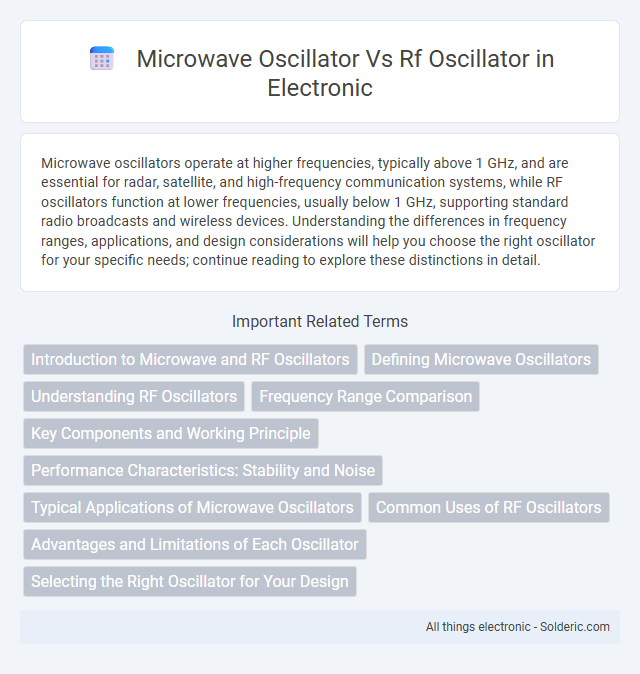Microwave oscillators operate at higher frequencies, typically above 1 GHz, and are essential for radar, satellite, and high-frequency communication systems, while RF oscillators function at lower frequencies, usually below 1 GHz, supporting standard radio broadcasts and wireless devices. Understanding the differences in frequency ranges, applications, and design considerations will help you choose the right oscillator for your specific needs; continue reading to explore these distinctions in detail.
Comparison Table
| Feature | Microwave Oscillator | RF Oscillator |
|---|---|---|
| Frequency Range | 1 GHz to 300 GHz | 3 kHz to 1 GHz |
| Wavelength | 1 mm to 30 cm | 30 cm to 100 km |
| Applications | Radar, satellite communication, microwave links | AM/FM radio, broadcast transmitters, wireless communication |
| Components | Gunn diodes, klystrons, magnetrons | LC circuits, crystals, varactors |
| Output Power | Typically low to moderate (mW to Watts) | Variable, generally higher than microwave oscillators |
| Stability | High frequency stability required, often uses phase-locked loops | Moderate stability, crystal oscillators improve accuracy |
| Size | Compact, specialized devices | Varies, generally larger LC components |
| Complexity | More complex due to high-frequency design challenges | Less complex, established technology |
Introduction to Microwave and RF Oscillators
Microwave oscillators operate at frequencies typically above 1 GHz, making them essential for high-frequency applications such as radar, satellite communication, and microwave radio links. RF oscillators function at lower frequencies ranging from a few kHz to several hundred MHz, widely used in audio, broadcast, and communication systems. Both types generate periodic signals, but microwave oscillators require specialized components like dielectric resonators or cavity resonators to maintain stability at higher frequencies.
Defining Microwave Oscillators
Microwave oscillators generate signals typically in the frequency range of 300 MHz to 300 GHz, essential for applications like radar, satellite communication, and high-frequency testing. Unlike RF oscillators, which operate below 300 MHz and are used in audio, radio, and low-frequency applications, microwave oscillators require specialized components such as cavity resonators or dielectric resonators to maintain stability at higher frequencies. These oscillators are designed to provide low phase noise and high spectral purity, critical for advanced wireless communication and precise signal generation.
Understanding RF Oscillators
RF oscillators generate continuous wave signals at radio frequencies typically ranging from kilohertz to several gigahertz, crucial for wireless communication, signal processing, and radar systems. Microwave oscillators operate at higher frequencies, usually above 1 GHz, designed for applications like satellite communication and radar targeting. Understanding RF oscillators helps you select appropriate frequency stability, phase noise, and power output for your specific electronic and communication system needs.
Frequency Range Comparison
Microwave oscillators typically operate in the frequency range of 1 GHz to 300 GHz, covering the upper microwave spectrum essential for high-frequency communication and radar applications. RF oscillators function within lower frequencies, usually spanning from a few kHz up to several GHz, which suits general wireless communication and signal processing tasks. Your choice depends on the required frequency band, with microwave oscillators ideal for ultra-high-frequency applications and RF oscillators better for broader, lower-frequency uses.
Key Components and Working Principle
Microwave oscillators utilize high-frequency components such as Gunn diodes, cavity resonators, and reflex klystrons to generate signals typically above 1 GHz, relying on the active device's negative resistance or electron beam modulation for sustained oscillations. RF oscillators operate at lower frequencies, often using LC circuits, quartz crystals, or tank circuits combined with transistors or vacuum tubes, where feedback loops maintain consistent oscillation. Understanding the distinction in your application involves recognizing the frequency range and the resonator type critical to the oscillator's stability and output signal purity.
Performance Characteristics: Stability and Noise
Microwave oscillators exhibit superior frequency stability and lower phase noise compared to RF oscillators due to their high Q-factor resonators and advanced design techniques used in high-frequency applications. Your system's performance benefits from microwave oscillators' reduced jitter and enhanced spectral purity, crucial for radar and communication systems. However, RF oscillators offer adequate stability with simpler, more cost-effective designs suitable for lower-frequency needs.
Typical Applications of Microwave Oscillators
Microwave oscillators are predominantly used in radar systems, satellite communications, and microwave radio relay links due to their ability to generate stable high-frequency signals above 1 GHz. These oscillators enable precise signal generation required for accurate target detection and high-bandwidth data transmission in wireless networks. In contrast, RF oscillators generally operate at lower frequencies and are commonly employed in applications such as AM/FM radio broadcasting, audio signal generation, and basic wireless communication systems.
Common Uses of RF Oscillators
RF oscillators are widely used in communication systems for signal generation, frequency synthesis, and carrier wave transmission in radios, televisions, and mobile phones. They play a critical role in radar systems, enabling accurate detection and ranging by producing stable and precise frequencies. Furthermore, RF oscillators are essential in electronic test equipment for calibration and frequency standards.
Advantages and Limitations of Each Oscillator
Microwave oscillators offer high-frequency stability and low phase noise, making them ideal for radar and satellite communication, but they often require complex designs and expensive components. RF oscillators are simpler, more cost-effective, and efficient at lower frequencies, yet they struggle to maintain performance at microwave frequency ranges. Understanding your application requirements helps determine whether the precise, high-frequency capabilities of microwave oscillators or the practical efficiency of RF oscillators best suit your needs.
Selecting the Right Oscillator for Your Design
Selecting the right oscillator for your design depends on frequency range, stability, and application requirements. Microwave oscillators operate at gigahertz frequencies ideal for radar, satellite communication, and high-speed wireless systems, while RF oscillators typically cover lower frequencies suitable for AM/FM radios, transmitters, and audio devices. Your choice should prioritize the oscillator's phase noise performance, power consumption, and integration compatibility specific to your system's operational environment.
microwave oscillator vs rf oscillator Infographic

 solderic.com
solderic.com